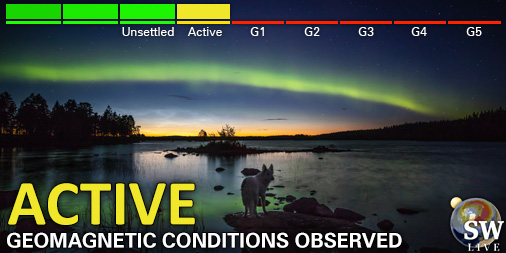Visualizzazione archivio di domenica, 30 settembre AM
Rapporto attività solare
Ogni brillamento solare menzionato nel rapporto ha un fattore di scala, applicato dal Centro di Predizione Meteorologica Spaziale (SWPC). A causa del fattore di scala del SWPC, i brillamenti solari sono segnalati come ridotti del 42%, rispetto ai dati di qualità scientifica. Il fattore di scala è stato rimosso dai nostri dati archiviati sui brillamenti solari, per riflettere le unità fisiche reali.
Rapporto dell'Attività Geofisica Solare 2001 Sep 30 2200 UTCPreparati dal SWPC della NOAA© ed elaborati da SpaceWeatherLive.com
Rapporto Congiunto USAF/NOAA dell'Attività Solare e Geofisica
SDF Numero 273 Emesso alle 2200Z il Sep 30 2001IA. Analisi delle Regioni Solari Attive e Attività dalle 2100Z-29 alle 2100Z-30
Solar activity remained at moderate levels. Region 9628
(S17W76) produced a long-duration M1/Sf flare at 30/1141 UTC
associated with minor discrete frequency radio emission. Region 9628
may have decayed a bit as it approached the west limb, but remained
large and complex. Decay was also noted in Region 9632 (S18W61) as
its large interior spot mass began to split, which may have
dissipated the magnetic delta structure contained therein.
Nonetheless, this region remained large and complex. Region 9636
(N14W15), a reverse-polarity sunspot group, showed gradual
development during the day. It was moderate in size and complexity
as it produced isolated subflares, none of which were associated
with significant X-ray or radio emission.
IB. Previsione dell'Attività Solare
Solar activity is expected to remain
at moderate levels. Isolated M-class flares will be possible from
Regions 9628, 9632, and 9636. Regions 9628 and 9632 each could
produce an isolated major flare before they rotate out of view on 01
and 02 October, respectively.
IIA. Sommario dell'Attività Geofisica dalle 2100Z-29 alle 2100Z-30
Geomagnetic field activity ranged from quiet to minor storm levels.
Minor storm levels occurred globally during 29/2100 - 2400 UTC
following a sustained period of southward IMF Bz (as measured by
NASA's ACE spacecraft). Activity decreased to quiet to unsettled
levels during 30/0000 - 1500 UTC, then increased to active levels
for the rest of the period. An interplanetary shock passed the ACE
spacecraft at 30/1848 UTC. The source for this shock may have been a
CME that followed a long-duration M3/2n flare from Region 9636 at
28/0830 UTC. The greater than 10 MeV event that began at 24/1215 UTC
ended at 30/1710 UTC.
IIB. Previsione dell'Attività Geofisica
Active geomagnetic conditions
will be possible during 01 - 02 October due to recent CME activity.
Field activity is expected to decrease to quiet to unsettled levels
on 03 October. There will be a slight chance for a proton flare from
Region 9628 or 9632 during the period.
III. Probabilità dell'Evento dalle Oct del 01 alle Oct del 03
| Classe M | 80% | 75% | 70% |
| Classe X | 25% | 20% | 10% |
| Protone | 20% | 15% | 10% |
| PCAF | yellow | ||
IV. Flusso di 10.7 cm di Penticton
Osservato 30 Sep 236 Previsto 01 Oct-03 Oct 230/225/225 Media di 90 Giorni 30 Sep 176
V. Indici Geomagnetici A
Osservato Afr/Ap 29 Sep 019/021 Stimato Afr/Ap 30 Sep 012/012 Previsto Afr/Ap 01 Oct-03 Oct 020/015-015/012-012/012
VI. Probabilità dell'Attività Geomagnetica dal 01 Oct al 03 Oct
| A. Latitudini Medie | |||
|---|---|---|---|
| Attivo | 40% | 40% | 30% |
| Tempesta minore | 20% | 20% | 10% |
| Tempesta maggiore-grave | 10% | 10% | 01% |
| B. Latitudini Alte | |||
|---|---|---|---|
| Attivo | 50% | 50% | 35% |
| Tempesta minore | 25% | 25% | 15% |
| Tempesta maggiore-grave | 15% | 15% | 01% |
Tutti gli orari in UTC
<< Vai alla pagina della panoramica giornaliera
Al momento non c'è meteorologia spaziale degna di nota
Ultime notizie
Ultimi messaggi dal forum
2025/04/12-13 Filament CMEs 2025/04/16 G3 Watch 506May 2024 storm created a new Van Allen belt 29AR4062 41Incoming & Unnumbered Active Regions 1748Ask your obscure/"stupid" space weather questions. 362
Altri argomentiSupporta SpaceWeatherLive.com!
Molte persone vengono su SpaceWeatherLive per seguire l'attività del Sole o sapere se ci sia la possibilità di vedere l'aurora, ma a maggior traffico corrispondono costi maggiori. Considerate una donazione se vi piace SpaceWeatherLive così che possiamo mantenere online il sito web!

Ultimi avvisi
04:15 UTC - Attività geomagnetica
Condizioni geomagnetiche attive (Kp4) Soglia Raggiunta: 03:57 UTC
02:30 UTC - Indice di potenza emisferica
Il modello OVATION prevede che l'indice di potenza emisferica raggiunga i 50GW alle 03:23 UTC
mercoledì, 16 aprile PM
21:45 UTC - Attività geomagnetica
Tempesta geomagnetica G1 minore (Kp5) Soglia Raggiunta: 21:36 UTC
21:00 UTC - Attività geomagnetica
Tempesta geomagnetica G1 grave (Kp5) Soglia Raggiunta: 20:55 UTC
19:45 UTC - Attività geomagnetica
Tempesta geomagnetica G1 forte (Kp5) Soglia Raggiunta: 19:25 UTC
Notizie sul meteo spaziale
| Ultimo brillamento X | 2025/03/28 | X1.1 |
| Ultimo brillamento M | 2025/04/15 | M1.2 |
| Ultima tempesta geomagnetica | 2025/04/16 | Kp8- (G4) |
| Giorni senza macchie | |
|---|---|
| Ultimo giorno senza macchie | 2022/06/08 |
| Media mensile Numero di Macchie Solari | |
|---|---|
| marzo 2025 | 134.2 -20.4 |
| aprile 2025 | 120.5 -13.7 |
| Ultimi 30 giorni | 118.3 -22.1 |






